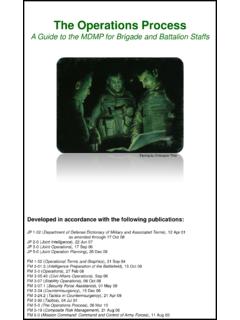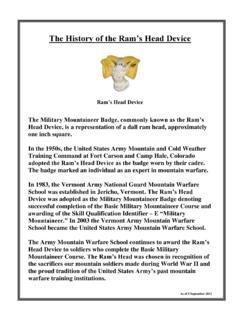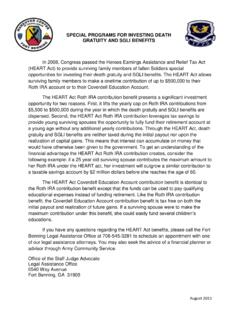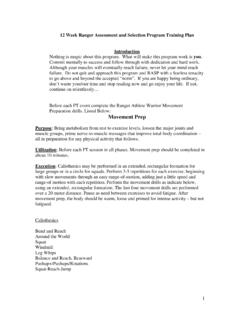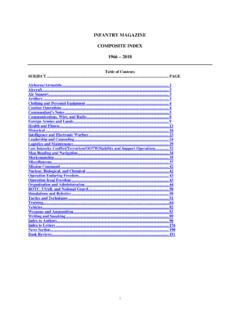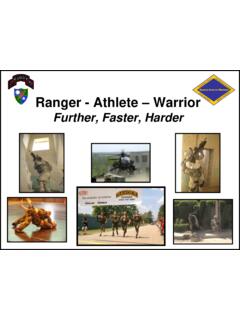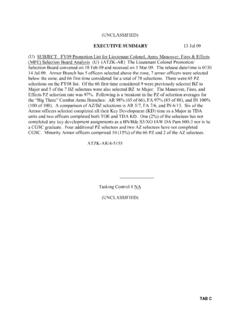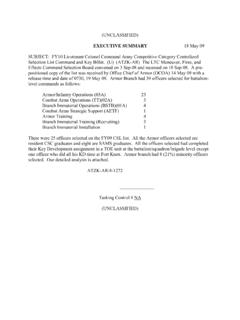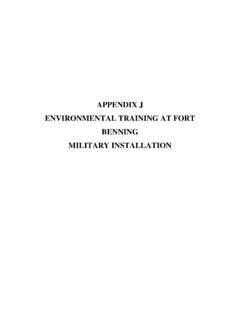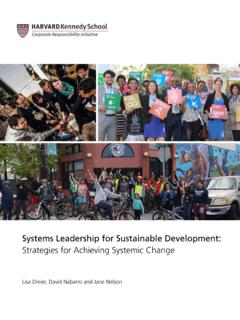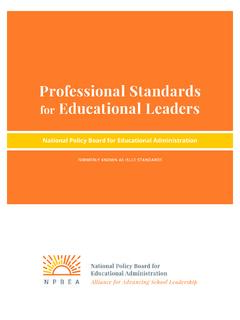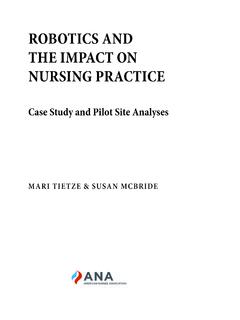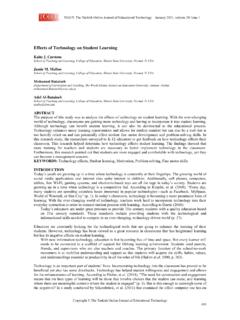Transcription of COMMON FACULTY DEVELOPMENT INSTRUCTOR COURSE
1 COMMON FACULTY DEVELOPMENT . INSTRUCTOR COURSE . STUDENT BOOK. VERSION Page 1. Homework Website: Page 2. COMMON FACULTY DEVELOPMENT PROGRAM INSTRUCTOR COURSE . STUDENT GUIDE TABLE OF CONTENTS. Lesson 1: COURSE Introduction What is Army University Supposed to Do and How Is It Going So Far? Pg. 7. General Learning Outcomes White Paper Pg. 13. INSTRUCTOR Competencies Pg. 35. Lesson 2: Fundamentals of Adult teaching and Learning The Five-Stage Model of Adult Skill Acquisition Pg. 41. Lesson 3: Foundations of Adult Learning TP 350-70-7 Adult Learning and Army U Experiential Learning Model Pg. 49. Lesson 4: Foundations of Instruction (Experiential Learning).
2 Appendix B: The Experiential Learning Model Pg. 53. Appendix C: The ELM Job Aid Pg. 58. Appendix G: Relationships between Learning Domains, Levels of Learning, and Los Pg. 59. TP 350-70-14 Instructional strategy and methods of instruction Pg. 67. Kolb Learning Styles Definitions and Descriptions Pg. 69. Lesson 5: Formative Practicum (Experiential Learning). Advanced Organizer Pg. 73. Lesson 6: Applied Critical Thinking (ACT) Tools and Groupthink Mitigation Techniques (GTM). Liberating Structures Pg. 77. Chapter IV: Critical Thinking Pg. 91. Chapter V: GTM & Decision Support Pg. 103. Appendix D: Handout-Select ACT Tool and GTM techniques Pg.
3 111. Questions Overview Pg. 117. Lesson 7: Foundations of Instruction (Direct Instruction). Handout #1: INSTRUCTOR roles Pg. 123. Ten roles for Teacher leaders Pg. 125. Handout #2: Classroom Management Strategies Pg. 129. Handout #3: The Communication Process Pg. 133. Handout #4: Active Listening Pg. 137. Handout #5: Effective Questioning Techniques Pg. 139. Handout #6: Asking Question to Improve Learning Pg. 143. Handout #7: MOIs; Lecture, Demonstration, Drill and Practice, and Practical Exercise Pg. 147. TRADOC Regulation 350-70: INSTRUCTOR /Facilitator requirements Pg. 153. Twenty Ways to Make Lectures More Participatory Pg.
4 155. Lesson 8: Formative Practicum (Direct Instruction). Lesson 9: The Army INSTRUCTOR as a Professional Appendix B: ADRP 1 (extract) Pg. 163. Appendix C: ADRP 6-22 (extract) Pg. 165. Appendix D: Characteristics of Good INSTRUCTOR /Facilitators Pg. 167. Appendix E: Training New and Current INSTRUCTOR /Facilitators Pg. 169. Appendix F: Guidance Concerning Works Protected By Copyright Pg. 179. Appendix G: TRADOC Regulation 350-70 (extract) Pg. 181. Appendix H: Copyright Basics Pg. 183. Appendix I: How to Obtain [Copyright] Permission Pg. 199. Page 3. COMMON FACULTY DEVELOPMENT PROGRAM INSTRUCTOR COURSE .
5 STUDENT GUIDE TABLE OF CONTENTS. Lesson 9: The Army INSTRUCTOR as a Professional continued Appendix J: Generic Request for Copyright Permission Pg. 201. Appendix L: Trust Handout Pg. 203. Appendix M: Cape Research Fact Sheet Trust Pg. 205. Lesson 10: Foundations of Instruction (Collaborative/Interactive Instruction). Topic Discussion Overview Pg. 209. Brainstorming Overview Pg. 213. Brainstorming: Key Points Pg. 217. Brainstorming Variations Pg. 218. Problem Solving Information Pg. 221. Committee Problem Solving: Key Points Pg. 228. Role Playing Pg. 229. Case Study Pg. 231. Lesson 11: Final Practicums (Summative).
6 Glossary Abbreviations Pg. 235. Glossary Pg. 237. INSTRUCTOR Competencies Pg. 243. Principles of Adult Learning Pg. 245. ELM Job Aid Pg. 247. Page 4. Lesson 1. Introduction Action: Describe the purpose of the COURSE . Conditions: In a classroom or training site, with appropriate graphical training aids, given various learning activities, student handouts, advance readings, and peer and INSTRUCTOR feedback. Standards: The description will include: The COURSE outcome and sequence of lessons An overview of the Army Learning Concept An overview of the Army University A description of INSTRUCTOR Competencies and General Learning Outcomes: An overview of the lesson learning objectives Learning Domain - Level: None assigned Page 5.
7 Page 6. What is Army University Supposed to Do and How Is It Going So Far? MG John Kem, Army LTC Andrew T. Hotaling, Army Army University Press/Journal of Military Learning Retrieved from The Army has always placed tremendous emphasis on training and education. It is a foundational part of our culture, dating back to Washington and Von Steuben training that transformed the Continental Army at Valley Forge, the founding of West Point in 1802, the establishment of the School for Cavalry and Infantry at Fort Leavenworth in 1881, and most recently, the establishment of Army University on 5 June 2015.
8 Warfare is and will remain the most difficult of human endeavors, and in the multifaceted world of today, developing soldiers and civilians with the technical, professional, and leadership skills to win in a complex world is more important than ever. The Army has never stood still when it comes to improving training and education, but recently Army leadership has recognized that the rate of change in the operating environment necessitates a true transformation in the way we approach learning in the Army to ensure readiness of our forces now and far into the future. We needed a more innovative enterprise-wide approach to create a culture of career-long learning and to dramatically increase the rate of innovation across the Army.
9 What Will Army University Do? The launch of Army University defined eight key objectives to address innovation and reinvigorate learning across the Army: 1. Develop a world-class FACULTY 2. Professionalize curriculum DEVELOPMENT 3. Grow qualified students 4. Adopt nationally recognized standards 5. Improve professional research and publication 6. Expand public-private partnerships 7. Implement new business and governance practices 8. Create an innovative learning environment1. These objectives, while not easy to achieve, are easily recognized by other services and the very best colleges and universities as key objectives of an institute of higher learning.
10 The Army and other services, however, must also address three key attributes that set them apart from a typical model for higher education: (1) we are the end user of our students, (2) we must address a full spectrum of learning for a wide variety of cohorts with varied educational backgrounds (civilian, enlisted, commissioned officer, and warrant officer), and (3) we must provide effective learning throughout a career. Soldiers complete their training and education courses and then fill our operational and institutional units, providing the technical skills, professional expertise, and leadership of Army units whether active duty, Army Reserve, or National Guard.
